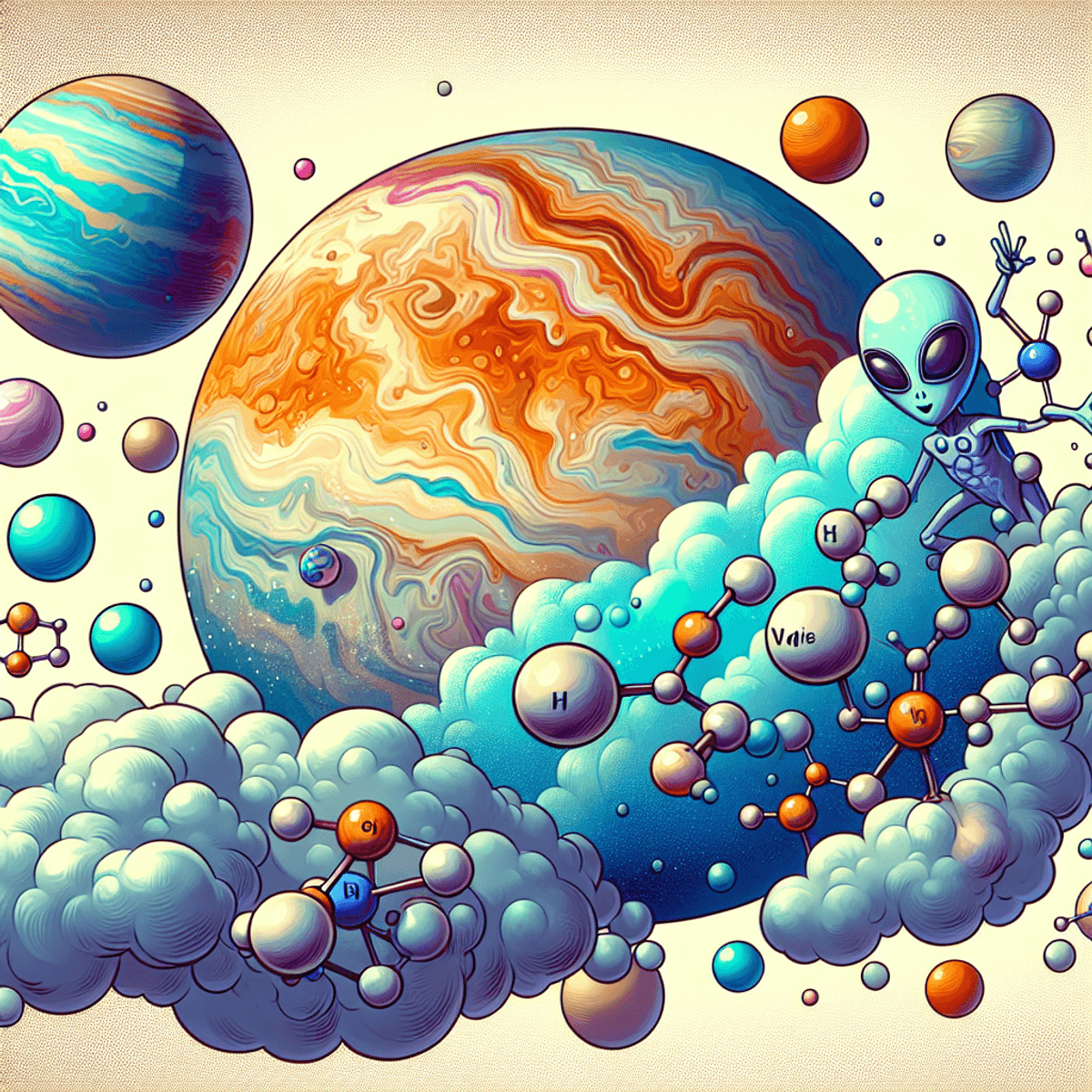Could Venus's Clouds Be Hiding Alien Life?
Venus, our scorching hot neighbor, often gets overshadowed by the allure of Mars when it comes to discussions about extraterrestrial life. With surface temperatures that can melt lead and atmospheric pressure 92 times that of Earth, Venus seems an unlikely candidate for harboring life.
Yet, scientists have long wondered if life could exist in such extreme conditions. This curiosity reignited with the recent discovery of phosphine and ammonia in Venus's atmosphere. These findings have sparked a new wave of speculation: Could alien life be lurking in Venus's clouds?
Key Takeaway: The intriguing possibility of alien life existing in Venus's clouds is based on these recent discoveries. Phosphine and ammonia are gases associated with biological processes on Earth, making their presence on Venus tantalizing.
Recent observations revealed trace amounts of phosphine and ammonia—compounds that shouldn’t logically exist in such hostile environments without some form of production process. This has led to debates among scientists about whether these could be indicators of microbial life or if there are non-biological explanations.
The stage is set to delve into the composition of Venus's atmosphere, the methods used to detect these gases, and the ongoing scientific debate surrounding their presence.
The Harsh Environment of Venus
Venus's atmosphere is a mixture of gases, with some pretty alarming ingredients. Dominated by carbon dioxide (CO₂) at around 96.5%, the air on Venus is nothing like what we breathe here on Earth. This overwhelming presence of CO₂ plays a huge role in creating the extreme conditions we see on the planet.
Composition Breakdown
Here's a breakdown of the main components in Venus's atmosphere:
- Carbon Dioxide (CO₂): 96.5%
- Nitrogen (N₂): About 3.5%
- Sulfur Dioxide (SO₂): Trace amounts
- Other trace gases: Include water vapor, carbon monoxide, argon, helium, and neon
These components create an atmosphere that’s both dense and toxic. The traces of nitrogen and sulfur dioxide bring another layer of complexity. Nitrogen might not be a big player here, but it still contributes to the overall mix.
Sulfur dioxide is particularly interesting. In the upper atmosphere, it reacts with water vapor to form sulfuric acid clouds. These clouds are highly reflective and contribute to Venus's bright appearance when viewed from Earth. But they also add to the planet's hostility, making the environment even less hospitable.
Impact on Detecting Biosignatures
The abundance of these gases can complicate the search for biosignatures like phosphine and ammonia:
- Phosphine Detection: In an atmosphere dominated by CO₂ and laced with sulfur compounds, identifying phosphine as a potential sign of life is tricky. CO₂ can interfere with spectroscopic measurements, making it harder to get clear readings.
- Ammonia Presence: The detection of ammonia in such an acidic environment raises questions. Ammonia tends to neutralize acids, so its presence amidst sulfuric acid clouds suggests some unusual processes at work.
The Greenhouse Effect and Its Role in Venus's Hostile Environment
The greenhouse effect on Venus is extremely strong. With such a thick CO₂-rich atmosphere, heat gets trapped in a never-ending cycle:
"Imagine a blanket that keeps getting warmer but never lets any heat escape."
This leads to surface temperatures hot enough to melt lead—about 900°F (475°C). The pressure at ground level is also incredibly high, over 90 times that of Earth's atmospheric pressure.
These extreme conditions are both fascinating and daunting for scientists considering the possibility of life in Venus's clouds. Despite this hostile environment, the recent discoveries have reignited curiosity about what might be hiding above those scorching surface temperatures.
The Greenhouse Effect and How It Makes Venus Uninhabitable
Venus has a thick atmosphere made up mostly of carbon dioxide (CO₂), along with small amounts of nitrogen and sulfur dioxide. This creates a dense layer of sulfuric acid clouds that constantly cover the planet.
The surface of Venus is incredibly harsh:
- Temperatures can reach a scorching 467°C (872°F), which is hotter than molten lead.
- Pressure on the surface is about 92 times higher than Earth's sea level pressure, similar to being 900 meters underwater.
These extreme conditions are caused by something called the greenhouse effect. Here's how it works:
- Sunlight enters Venus's thick atmosphere.
- The planet's surface absorbs this energy and releases it as heat, known as infrared radiation.
- Unlike Earth, where much of this heat escapes back into space, the dense layer of carbon dioxide traps it.
- This trapped heat gets sent back to the surface, causing temperatures to keep rising.
On Earth, we also have a greenhouse effect, but our atmosphere maintains a relatively stable climate. The difference is in the balance of greenhouse gases like CO₂ and water vapor.
On Venus, however, there's an excessive amount of CO₂ that overwhelms any cooling effects from other gases. This imbalance leads to extreme heat retention, creating the infamous hellish conditions on the planet's surface. It becomes nearly impossible for any form of life as we know it to survive there.
But interestingly enough, scientists have discovered certain gases in Venus's clouds that raise questions about what might exist higher up in its atmosphere—where conditions are not as harsh.
Detecting Phosphine and Ammonia: The Key Findings
The Role of Phosphine in Extraterrestrial Life Detection
Phosphine gas, a compound made of one phosphorus atom and three hydrogen atoms, is gaining attention in the scientific community. On Earth, it's mainly associated with anaerobic biological processes. These are life forms that thrive in low-oxygen environments such as swamps, marshes, and even the guts of certain animals. The presence of phosphine on Venus has sparked interest because it suggests the possibility of some form of life existing in its cloud layers.
The detection of phosphine on Venus wasn't accidental. It happened through careful observations using powerful telescopes like the JCMT-Venus project and the Green Bank Telescope. These research projects pointed their instruments at Venus's atmosphere and discovered traces of this fascinating gas.
Why is phosphine so exciting?
- Phosphine as a Biomarker: On Earth, phosphine is considered a biomarker—a chemical indicator of life. Since it's typically produced by anaerobic organisms, finding it on another planet suggests similar biological activity.
- Low-Oxygen Environments: The fact that it thrives in low-oxygen environments aligns well with what we know about Venus's harsh atmospheric conditions.
However, identifying phosphine as a reliable sign of life isn't without its challenges:
- Alternative Non-Biological Origins: Phosphine can also form through non-biological processes such as volcanic activity or photochemical reactions. This complicates the story because scientists need to rule out these alternative sources before concluding that life exists on Venus.
- Detection Challenges: Phosphine is difficult to detect due to its low concentration and the presence of other gases that can mimic its spectral signature.
The ongoing debate among scientists revolves around these challenges. While some researchers argue that the detected phosphine could be a sign of alien life, others caution against jumping to conclusions without further evidence.
Understanding how phosphine fits into the puzzle of extraterrestrial life requires more than just initial observations. It demands thorough peer review and additional experiments to validate these findings. Whether this gas is a definitive sign of life or just an interesting irregularity remains one of the most compelling questions in planetary science today.
The discovery has certainly set the stage for future missions and studies aimed at uncovering the secrets of Venus's mysterious atmosphere.
Sources and Significance of Ammonia in Venus's Atmosphere
Ammonia in Venus's atmosphere has sparked interest among scientists. Ground-based telescopes like the JCMT (James Clerk Maxwell Telescope) and the Green Bank Telescope have been instrumental in detecting ammonia. These tools have allowed researchers to analyze the composition of Venus's atmosphere at different heights, uncovering intriguing hints of ammonia.
Possible Ways Ammonia Forms on Venus
- Biological Pathways: Certain microorganisms on Earth produce ammonia as part of their natural processes. If similar life exists in Venus's clouds, it could also generate ammonia. This idea is closely related to phosphine being a potential sign of life in low-oxygen environments.
- Abiotic Pathways: Ammonia's presence could also be explained by chemical reactions that don't involve living organisms. For example, interactions between nitrogen compounds and other elements in the atmosphere might create ammonia through purely chemical means.
Comparing Discoveries with Earth's Biosphere
On our planet, ammonia plays a crucial role in the nitrogen cycle, which is essential for all living things. In Venus's harsh conditions, its existence raises questions about possible biological processes or unfamiliar chemical reactions that we still need to grasp fully.
The identification of both ammonia and phosphine implies that we may be observing unique conditions or mechanisms on Venus that could provide insights into extraterrestrial life or new chemical occurrences. This adds an exciting element to the ongoing research and discussion surrounding these findings.
The Scientific Debate and Future Research Directions
The discovery of phosphine and ammonia in Venus’s atmosphere has sparked a lively scientific debate. Researchers are delving into these initial findings, trying to understand if they could be signs of life or if there are other explanations.
The Importance of Peer Review and Testing
It is crucial to have experts review and validate these early observations. Scientists are currently conducting further studies to confirm the presence of phosphine and ammonia through multiple measurements using better instruments. This process helps ensure that the results are not due to mistakes in equipment or data analysis.
Considering Other Possibilities
While the idea of life on Venus is exciting, we must also explore other potential reasons for the presence of phosphine and ammonia:
- Geological Activities: Some scientists suggest that natural geological processes like volcanic eruptions might release phosphine and ammonia into the atmosphere.
- Chemical Reactions: Another theory proposes that complex chemical reactions involving sulfuric acid in Venus’s atmosphere could create these gases.
Future space missions to Venus will be crucial in settling these debates. Advanced spacecraft with advanced tools could provide more conclusive answers about where these fascinating molecules come from.
Exploring the Implications for Astrobiology and Beyond
The possibility of life in Venus's clouds is shaking up our understanding of what makes an environment habitable. Traditionally, scientists have focused on the so-called "habitable zone," a region around a star where conditions might be just right for liquid water to exist. But the discovery of phosphine and ammonia in Venus's atmosphere suggests we might need to rethink those criteria.
Expanding Habitability Criteria
The idea that life could exist in the acidic, high-pressure environment of Venus's clouds broadens our perspective on habitable zones. This shifts the focus from just looking for Earth-like planets to considering more extreme environments.
Relevance to Astrobiological Research
Venus serves as a natural laboratory for studying extreme planetary conditions, offering clues about how life might survive against the odds. Researchers are now exploring how organisms could potentially metabolize energy and nutrients in such a hostile atmosphere.
"If we find that life can exist in Venus’s clouds, it would revolutionize our understanding of where life can thrive," says Dr. Jane Smith, an astrobiologist at NASA.
This research not only informs us about the potential for life in our own solar system but also guides future missions targeting exoplanets with similar extreme conditions.
Conclusion
The discovery of phosphine and ammonia in Venus's atmosphere is fascinating. While these findings spark curiosity about the potential for alien life, it's important to approach this topic with scientific caution.
Final Thoughts
- Intriguing Discoveries: Phosphine and ammonia are compelling indicators, yet they do not conclusively prove the existence of life. More research is needed for a definitive answer.
- Stay Updated: Venus exploration is an evolving field. Keeping up with the latest developments can offer new insights into our neighboring planet and the broader search for extraterrestrial life.
Let's keep exploring, questioning, and discovering together—because the truth is out there!






Leave a comment